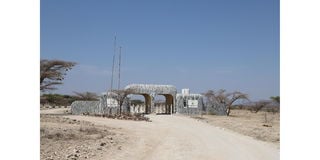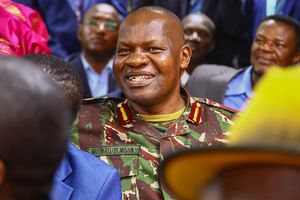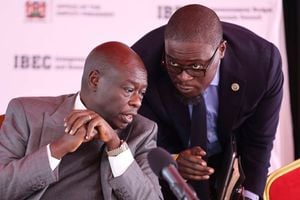Support the hungry by visiting Shaba National Reserve

Travel 2,Buffalo Springs National Reserve Chokaa Gate. Photo | pool
What you need to know:
There has been an eight-month-long drought and the Samburu village, survive on the money guests pay for these visits
Shaba National Reserve in Isiolo is one of the few Kenyan national parks I had not yet visited, along with the adjacent Buffalo Springs National Reserve. When the opportunity for a visit arose as part of the Magical Kenya Travel Expo 2022, I have never packed faster. It took us seven hours to get to the Natorbi Ogura gate, with two stops along the way including at Cedars Mall in Nanyuki which has a Java Cafe for coffee and pastry lovers.
We encountered a herd of buffaloes grazing right by the main gate, with yellow-necked spurfowl and buffalo weavers in tow. We were also greeted by Grevy’s zebra, a species only found north of the equator. Shaba is semi-arid, and the temperatures reflect that; I could practically feel my flesh sizzling under the heat. The landscape is also so white that it is blinding. Be sure to bring your sunglasses. The roads are rough so a car with good suspension would be ideal, and be ready for the passing cars that bathe you in a cloud of dust in their wake. And yet, the park is dotted with doum palm trees, which, when near a stream, looks like a little oasis. Season 3 of the Survivor TV show was shot here, apparently, and I cannot fathom how anyone could walk in the middle of the day without passing out.

Travel, Man standing outside house in a samburu village. Photo | Pool
During our two-day stay at Shaba, we spent a morning at Buffalo Springs National Reserve, going in through the Chokaa gate. This park is a haven for birders, with grey wren-warblers, pink-breasted larks, Somali bee-eaters, Hunter’s sunbirds and more. It’s interesting how bird watching sneaks up on you…you start off thinking it’s for old people, and next thing you know, you’re excited to spot a Marshall Eagle perched on top of a tree. Although, to be fair, who wouldn’t be excited to see Africa’s largest bird of prey, and marvel at its large wing span? This eagle can eat a small goat, and sometimes it drops them onto huge rocks to tenderise the meat.
We also spotted a dead warthog. It is interesting how carnivores will eat all the organs of their prey first, and save the body for later. It’s the equivalent of starting your meal with dessert, a noble pursuit in my books. Circling the area were wild dogs which no matter how much they look like your ‘Kenyan Shepherd’ called Scooby, never dare pet one unless your life goal is to become the Kenyan Captain Hook. There was a lone vulture eyeing the warthog carcass from a tree, and when I wondered out loud why it didn't just attack, I was told it was keeping watch and waiting for its friends to arrive; a whole master strategist. On our game drive, we also saw waterbucks, elands, giraffes, gerenuk antelopes and more.

Travel 3 A herd of zebra grazing at the national reserve. Photo | Pool
On the Western end of the park is Buffalo Springs, after which the reserve is named. This is a clear blue natural pool with a stone wall constructed along the perimeter. For those who enjoy adventure, it is one of the reserve’s main attractions. While it is may be referred to as a natural pool, it is in fact a bomb site. Apparently, an Italian fighter plane mistook a herd of buffalos for British tents heading to Ethiopia, and they dropped a bomb on them. I have seen enough social media posts of people jumping into the pool for a dip, and I was excited to finally have my turn. Imagine my disappointment, then, to learn that it’s presently not allowed because of Covid restrictions. Covid! This salty water is formed by rising underground steam which starts off in Mt Kenya, and we had to be content with taking pictures.
Our accommodation was at Sarova Shaba Game Lodge, right on the banks of the Ewaso Ng’iro River, the main source of water in this ecosystem. While in my chalet, I would hear the water rushing and think it was rain. There are comfortable wooden benches overlooking the river, perfect for having a drink while admiring the greenery. There is an electric fence, though, so rest assured that the Nile Crocodiles in the water will not be crossing over to make a meal of you. The lodge even has a fish pond where you can dip your feet for a pedicure.
Our group enjoyed a private dinner set in a clearing under the stars, with fairly lights, music, and a nyama choma station with all sorts of meats. We also had a champagne breakfast by the river, with a table bursting with pastries, bacon, sausages, fruits, eggs, cereal and more, and by the time the damage was done, I was tempted to lie down, but, alas, a cultural visit to a Samburu Village awaited.
We got to check out a Samburu homestead, and the leader, Tepis, informed us that there has been an eight-month long drought and they survive on the money guests pay for these visits. Considering our team of five paid Sh2,000 per person, and there was another group of tourists en route, it’s decent earnings. Everything they get is shared among the group. The women get additional income from selling curio which is laid out at the end of a tour.




